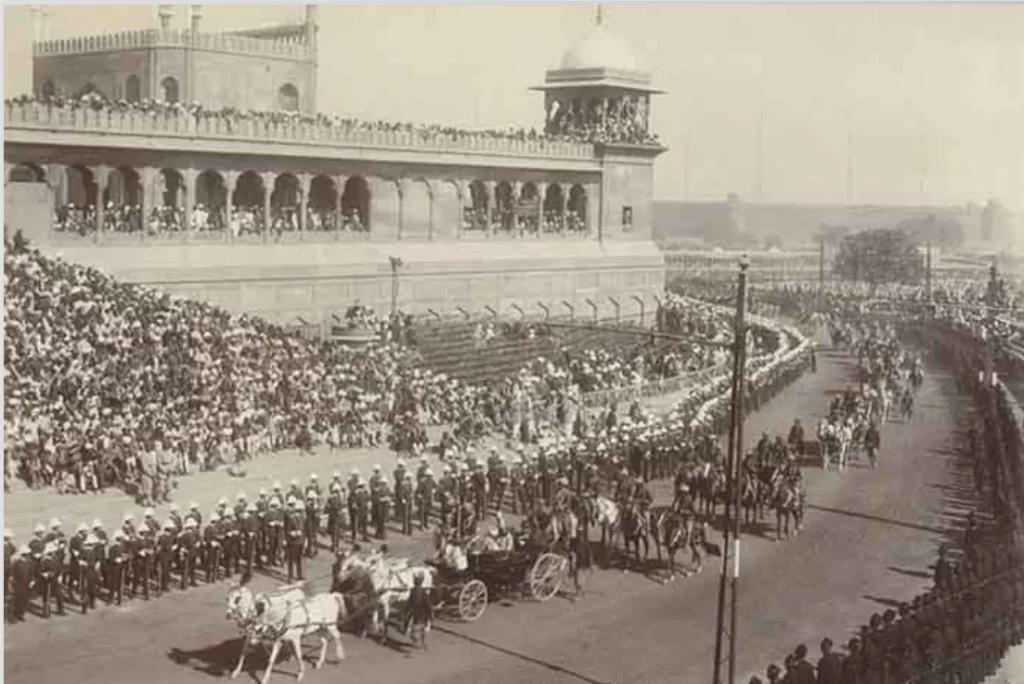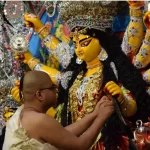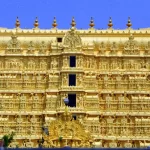Delhi Durbar | रोमांचक और इतिहासपूर्ण घटनाएं
The Viceroys hosted lavish celebrations known as the Delhi Durbars to commemorate the crowning of Emperors or Empresses. As a result, the Coronation Durbars were another name for these. The British took the Persian term “court of a ruler,” durbar, from the Mughals. The intention was to appear to the Indian populace as the Mughal successors.
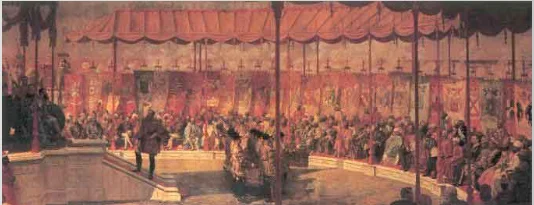
1877 Delhi Durbar
In 1876, Queen Victoria became the “Empress of India” in addition to her title as “Queen of Great Britain and Ireland.” She urged Lord Lytton, the Viceroy, to make this announcement across India.
For this reason, he decided to call an Imperial Assemblage to be held in Delhi on January 1, 1877. He invited all the governors, lieutenant governors, heads of state, ruling chiefs, princes, and nobility for this momentous occasion.
The fact that there were more attendees at the ceremony than the Viceroy had anticipated gives insight into the grandeur of this occasion.
Meetings of the Assemblage were place in open-air pavilions. As soon as the Viceroy entered the pavilion, the attendants greeted him with a royal salute and seated him on the Viceregal Throne in the middle. In a semicircle facing the throne sat governors, heads of administrations, ruling chiefs, native chiefs, and other prominent officials.
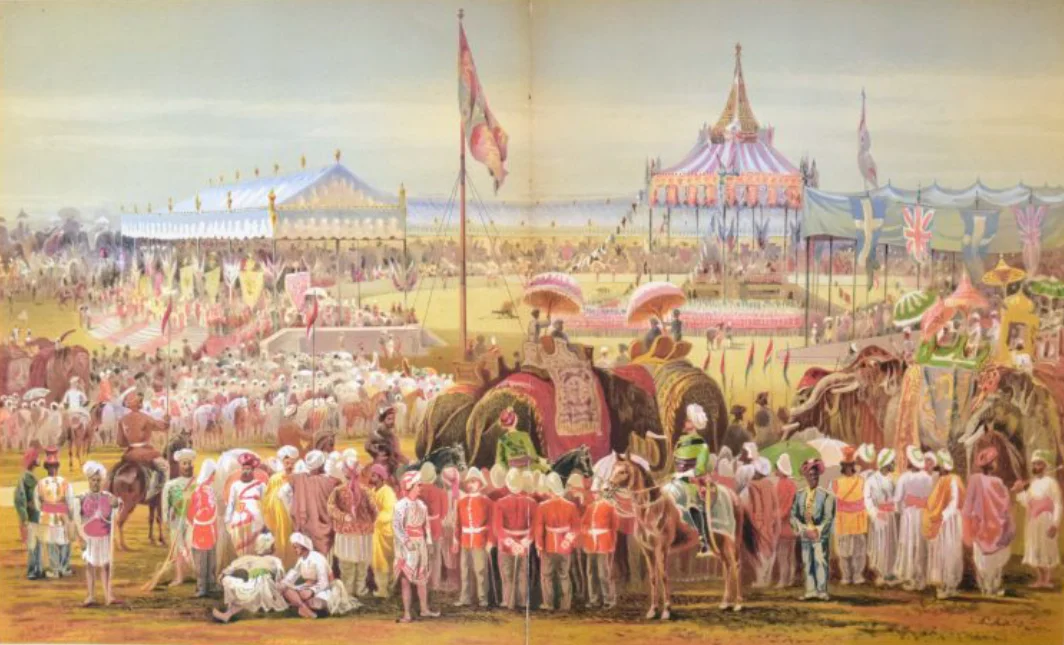
101 salvos of artillery
At the Assembly, they read out the Proclamation in both English and Urdu. Following this, they fired 101 artillery salvos in homage. After speaking to the assembly, the Viceroy gave each chief a gold medal and a banner bearing the Queen’s name.
One side of the gold medal featured a solemn portrait of Her Majesty, while the other had the words “Victoria Empress of India, 1st January 1877” in Hindi, English, and Urdu.
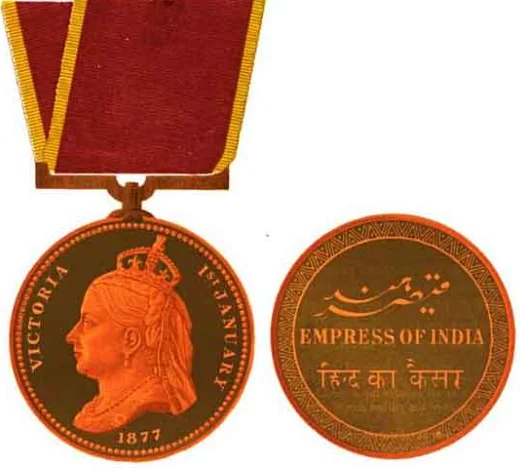
The banner was emblazoned with the chiefs’ armorial insignia on one side and an inscription stating that it was a gift from the Indian Empress on the other.
At this Durbar, two important choices were made:
Establishment of the Privy Council.
The Viceroy and other chiefs were entitled to a salute with that many guns.
The salute in British India was 101 guns for Her Majesty the Queen and Empress and 31 guns for the Viceroy of India. Various notable Indian chiefs received gun salutes of 21, 19, 17, 15, 11, and 9 based on their association with the British.
Delhi Durbar 1903
When the second Durbar took place in 1903, it was more than simply an Assembly—it was a lavish event that everyone aspired to attend. This Durbar signified Edward VII’s ascension. The Duke of Connaught was present at the request of King Edward VII.
It was necessary to prepare and organize this week-long festival, which also featured football and polo competitions, thus a Durbar Committee was established.
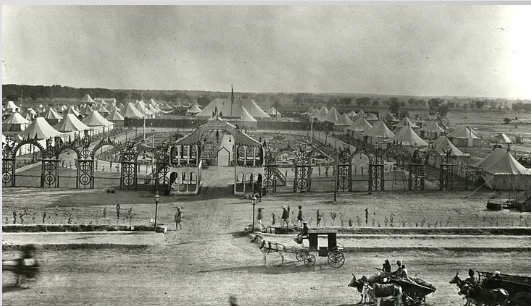
Visitors to the Darbar lodged in the well-appointed Provincial Camps, complete with running water and electricity. At night, string bands would perform, indicating that these camps were occupied all day.
Since his father had been granted this honour at the 1877 Darbar, the Maharaja of Benaras was excited to raise his ancestral flag at his camp. He desired the same rights that the Darbar Committee had bestowed upon him.
Royal State Entry
The Royal State Entry was the Durbar’s most anticipated event. A sizable crowd arrived to observe the Royal march. The parade for this Darbar was slated on December 29, 1902.
The British National Anthem was being performed by the bands when the Viceroy arrived at the station. The Ruling Chiefs and other authorities met him and hailed him.
Soon after, the Duke and Duchess of Connaught, the event’s principal guests, arrived. The bands at the platform played the British National Anthem as they arrived, and they were greeted with a royal salute.
The elephant parade started when the Viceroy, the Duke and Duchess of Connaught, and the others mounted the animals outside the station. The route started on Queen’s Road, went by the Jama Masjid, passed Chandni Chowk, went up the ridge near the Flagstaff Tower, and ended at the Viceroy’s Camp.
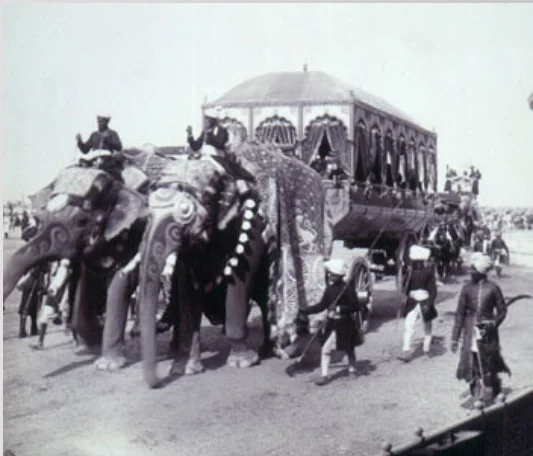
The coronation ceremony on January 1, 1903, was the centerpiece of the Delhi Durbar. An amphitheater was erected for this purpose. It was split up into various blocks numbered A through Y. The different Durbar visitors were assigned seats based on a hierarchy that was set.
The Durbar Committee was particularly concerned about how the Begums, who accompany the Maharajas at the Darbar, would be seated. Because of this, Block Y of this amphitheater was designated exclusively for purdahnashin, or veiled, females. In this particular block, seats were allotted for a total of fourteen women.
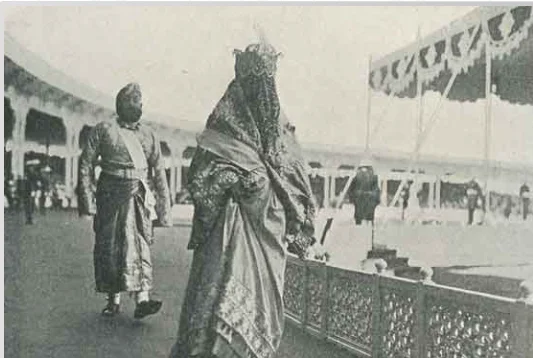
The Events that makes the Durbar unique
The 1903 Durbar was distinguished by two main events that were held there:
The Art Exhibition
- The Art Exhibition: The show’s director and assistant director made contact with some of the top local producers while touring India. Labels, tickets, and invoice forms were provided to the exhibitors; the items had to be shipped with them. These displays were transported to Delhi via rail at a discounted rate.At Qudsea Bagh, a structure was constructed; once the show was completed, it was taken down. The structure was divided into four parts and was saracene in style with fresco and title work:
- The Main or Sale Gallery
- The Loan Collection Gallery
- The Jewellery Court.
- The Artisans Gallery and Workshop
The State Ball
- The State Ball was a lavish occasion held in the Red Fort that included a ballroom and buffet feast. Both the Diwan-i-Am and the Diwan-i-Khas had brief renovations. There were covered passages from the Diwan-i-Am to the Diwan-i-Khas and from Salimgarh to the Diwan-i-Am. Beside the Diwan-i-Am, separate areas were designated for the Ballroom and the Buffet Room.Lord Curzon realized that the arches connecting the ballroom and the Diwan-i-Am were open to the elements, making the visitors uncomfortable on the day of the event.
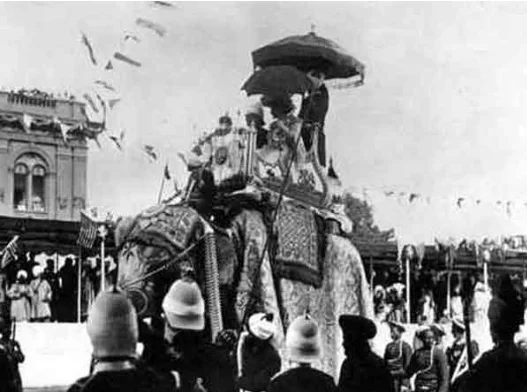
Bahadur Rai The superintendent of works, Ganga Ram, was instructed to investigate this. He made the decision to cover these arches with exquisite, thick drapes.
Comfortable drapes of a yellow-ochre hue adorned the arches that separated the ballroom from the buffet area. To keep the temperature stable, heating systems were put in the three major rooms.
A large number of Princes and officials received the gold and silver Delhi Durbar medals for their services to British India at the investiture event that was also held in the Red Fort. The gold medal that was awarded to the Nizam of Hyderabad was really misplaced. He persuaded the Viceroy to grant him a replacement at no cost by writing letters requesting one.
Another noteworthy aspect of this Durbar was the establishment of a sizable Telegraph Office in the Central Camp. The London Office received a telegraphed copy of the Viceroy’s address on January 1. In India, this was the first speech to be telegraphed.
Delhi Durbar 1911
The succession of King George V was announced in the Darbar of 1911. This Durbar was notable for two reasons: first, it was the only one that the Emperor personally attended, and second, it was the occasion when the announcement was made to move their Royal Capital from Calcutta to Delhi.
One of the main Durbar ceremonies, the Royal State Entry required careful planning and coordination by the Darbar Committee. The Viceroy, members of His Majesty’s Escort army, Ruling Chiefs, His Majesty’s Escort staff, and other authorities were part in the parade.
There were several conversations over how the procession should be organized and whether or not the chiefs should participate. It was determined that the Chiefs would accompany the royal procession following a number of suggested plans. The Nizam of Hyderabad, who was entitled to a 21-gun salute, led the parade of the Ruling Chiefs.
On December 7, 1911, the Emperor and Empress arrived in Delhi. They left Bombay via the Baroda, Bombay and Central India Railway, passing through Tundla, Agra, and Mathura. Instead of arriving at Central Station, they reached the Salimgarh Station Bastion.
There were bands performing at the station and a 101 gun salute to mark their magnificent arrival. After leaving the station, they went to the pavilion next to the Salimgarh gate, where additional officials and Ruling chiefs were waiting for them.
Following the Governor-General and Vice President of the Council’s addresses to the Imperial Majesties, the Royal Procession got underway.
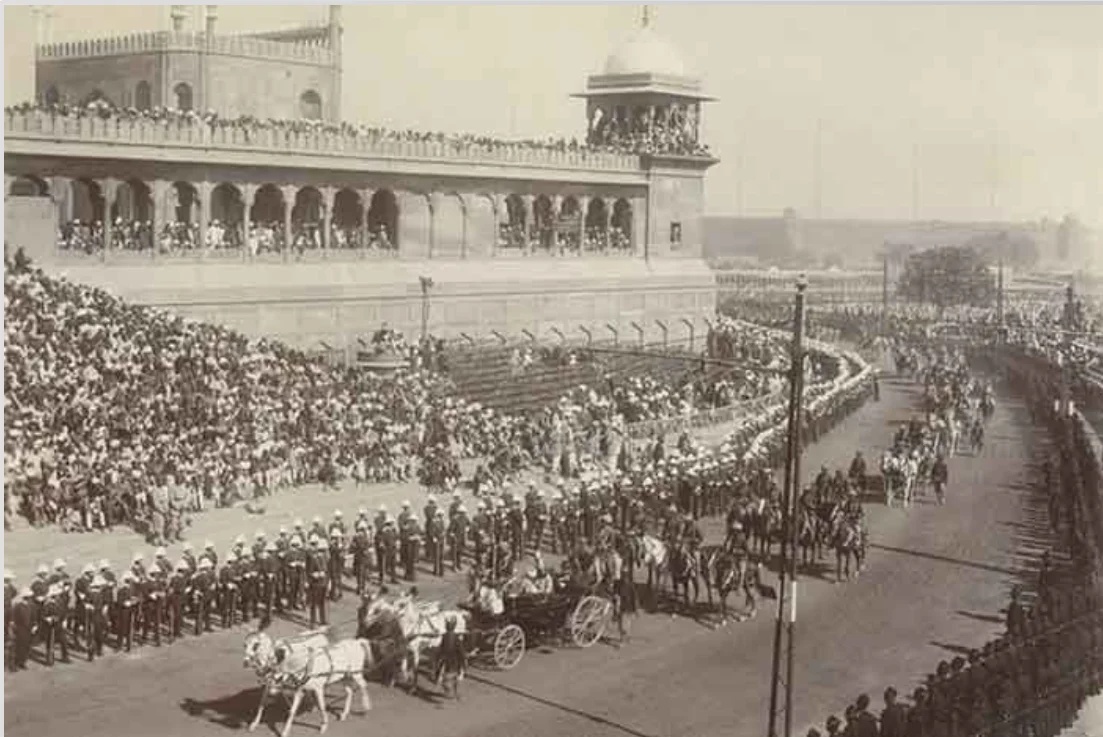
The Proclamation Ceremony
On December 12, the Proclamation Ceremony was held at the Durbar arena, which was located on the same site as the previous Durbars and had two amphitheaters. The public used the bigger, outer one, known as the Spectator’s Mound. The Durbar’s renowned visitors were to use the other, smaller amphitheater.
For a number of reasons, this 1911 Proclamation Ceremony generated a lot of discussion. First, upon reaching the amphitheater, the Maharaja of Gaekwar took off all of his jewelry, save only his medals and star, and gave them to his son, who was seated behind him. The Maharaja eventually apologized for what was seen to be his impolite behavior.
Second, the Darbar organizers knew well in advance of the Ceremony that several Ruling Chiefs were opposed to the Homage Ceremony’s requirement that they bow before the Emperor. Before their Imperial Majesties, they were supposed to kneel three times and retrace their steps to their positions.
As equals, they desired to meet the Emperor. Therefore, on the day of the ceremony, the Maharaja of Gaekwar made a single, partial bow in reverence to the King and Queen before turning around and walking to his position.
Many publications covered his behavior at the Delhi Durbar, which was deemed to be quite insulting on his behalf. On the British Resident’s guidance, he later expressed regret in his court.
Realisation
Following this significant event in the 1911 Delhi Durbar, the British were aware of the level of animosity that pervaded Indian thoughts. Although a fourth Durbar was considered, it could not be carried out for a number of reasons.
First of all, there was anarchy following King Edward VIII’s abdication of the crown. Second, the British were kept busy by certain circumstances that arose in various regions of Europe and ultimately sparked the Second World War.
Furthermore, India had already lost so much of its riches at this point that it was unthinkable to have another Durbar of the same magnitude.

